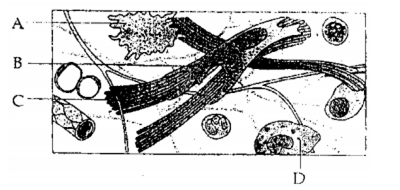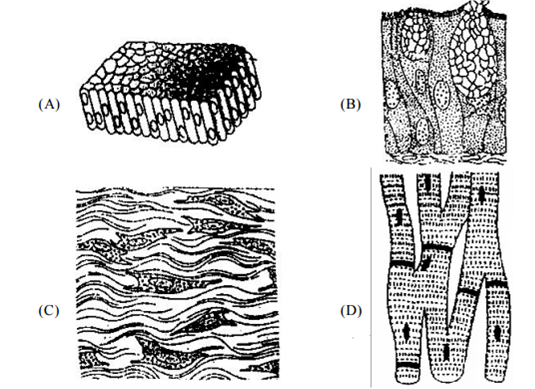 Multiple Choice Questions
Multiple Choice QuestionsGiven below is the diagrammatic sketch of a certain type of connective tissue. Identify the parts labelled A, B, C and D, and select the right option about them.
| Part A | Part B | Part C | Part D |
| Macrophage | Fibroblast | Collagen fibres | Mast cells |
| Part A | Part B | Part C | Part D |
| Mast cell | Macrophage | Fibroblast | Collagen fibres |
| Part A | Part B | Part C | Part D |
| Macrophage | Collagen fibres | Fibroblast | Mast cell |
| Part A | Part B | Part C | Part D |
| Macrophage | Collagen fibres | Fibroblast | Mast cell |
The four sketches (A, B, C and D) given below, represent four different types of animal tissues. Which one of these is correctly identified in the options given, along with its correct location and function?
| Tissue | Location | Function |
| Glandular epithelium | Intestine | Secretion |
| Tissue | Location | Function |
| Collagen fibres | Cartilage | Attach skeletal muscles to bones |
| Tissue | Location | Function |
| Smooth muscle tissue | Heart | Heart contarction |
| Tissue | Location | Function |
| Smooth muscle tissue | Heart | Heart contarction |
How many pairs of contrasting characters in pea plants were studied by Mendel in his experiments?
Five
Six
Eight
Eight
The terga, sterna and pleura of cockroach body are joined by
cementing glue
muscular tissue
arthrodial membrane
arthrodial membrane
C.
arthrodial membrane
Terga (dorsal sclerites), sterna (ventral sclerites and pleura (lateral sclerites are joined together by soft, colourless and flexible membrane called arthrodial membrane also known as intersegmental membrane.
It is also seen at the base of sensory hairs wings etc.
The ciliated columnar epithelial cells in humans are known to occur in
bronchioles and fallopian tubes
bile duct and oesophagus
fallopian tubes and urethra
fallopian tubes and urethra
Which of the following are correct states as it happens in the common cockroach?
Oxygen is transported by haemoglobin in blood
Nitrogenous excretory products is urea
The food is ground by mandibles and gizzard
The food is ground by mandibles and gizzard
Ground tissue includes
all tissue except epidermis and vascular bundles
epidermis and cortex
all tissues internal to endodermis
all tissues internal to endodermis
The cells lining the blood vessels belong to the category of
smooth muscle tissue
squamous epithelium
columnar epithelium
columnar epithelium
Frogs differ from humans in possessing
paired cerebral hemispheres
chymotrypsin
trypsin
trypsin
Consider the following four statements (I - IV)related to the common frog Rana tigrina, and select the correct option stating which ones are true (T) and which one are false (F).
I. On dry land it would die due to lack of O2 its mouth is forcibly kept closed for a few days.
II. It has four - chambered heart
III. On day land it turns uricotelic from ureotelic
IV. Its life -history is carried out in pond water.
|
I |
II |
III |
IV |
|
T |
F |
F |
T |
|
I |
II |
III |
IV |
|
T |
T |
F |
F |
|
I |
II |
III |
IV |
|
F |
F |
T |
T |
|
I |
II |
III |
IV |
|
F |
F |
T |
T |
